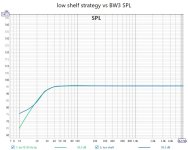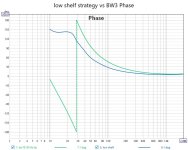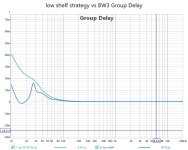Sure, but use Parametric band #2 for the boost at Fb and use parametric band #1 to create a dip to achieve the cutoff below resonance.in a pinch (with online content) - might a browser add-on such as "EQ8" do the job?
View attachment 1252428
@perrymarshall
Define small port 🙂
Which app to use to add GD at 30-40Hz and which amount should be audible?
Define small port 🙂
Which app to use to add GD at 30-40Hz and which amount should be audible?
@gedlee
For ready made solution:
1) subwoofer https://reckhorn.com/en/speaker/subwoofer/168/sw-300i-passive-subwoofer-ball-in-a-new-design?c=124
2) dedicated amp with EQ: https://reckhorn.com/en/amplifier/7...9-with-complete-frequency-and-room-adjustment
For ready made solution:
1) subwoofer https://reckhorn.com/en/speaker/subwoofer/168/sw-300i-passive-subwoofer-ball-in-a-new-design?c=124
2) dedicated amp with EQ: https://reckhorn.com/en/amplifier/7...9-with-complete-frequency-and-room-adjustment
What about Big Port, tuned low, lost of damping material. In HornResp the Harmonics are tamed pretty well with a little bit of damping material.There is a highly informative thread on ports thanks to the experimental nature of @stv, that shows 'big' ports create specific issues too, midrange leakage.
Lots of damping material will significantly reduce useful bass output, but if that's ok for you it is a viable option.lost of damping material
I don't think there is anther option is there? Outside of shrinking the CSA of the port. I always wondered about very skinny but wide ports.
If you use any of the good simulation programs you can apply high power and see what the port velocity is.@perrymarshall
Define small port 🙂
Which app to use to add GD at 30-40Hz and which amount should be audible?
A simple online program is here - http://sbp.softica.dk/2.0/en/ you can see what port velocity is at 200 watts. You don't want air speed in the port to exceed about 20 meters per second. Even small woofers like 8" deserve a 3" diameter port. Make a bigger difference than most people would think.
I like MiniDSP. There are lots of other DSP solutions available.
it also depends on the xmax, required spl, tuning frequency, port shape ...Even small woofers like 8" deserve a 3" diameter port.
@mark100 it's true that all identical curves have identical phase, but shelf filters have less phase shift because they level off at very low frequencies. So they're a different animal than standard High Pass.
Interesting strategy for sure. Thx!
I think you'll like this......
Here's a transfer function where the reference signal is a 30Hz 18dB/oct Butterworth high-pass; and the measurement signal is the shelving strategy.
I was trying to see how close I could get the shelving strategy to match the 30Hz hpf, and then compare their phase and group delays.
I didn't want the upward bump in response the Q=2 strategy gives, I just wanted to replace the 30Hz BW3. So the shelving Q ended up at about 1.
You can see the shelf settings and a couple of small PEQ on the left side screens. The 30Hz hpf on the upper right.
The lower right screen, labeled Responsalyzer is a dual channel FFT showing the magnitude transfer function between the two.
Here's some REW screens of the matchup.
SPL, phase, group delay.



Must say i'm very intrigued by the strategy.
I can see that the Q=1 doesn't continue to closely follow the BW3 below about 17Hz, but I'll check Hornresp for excursion ...hopefully no issue.
If there is an issue I'll play with raising the shelf's Q and rematch.
'Cause I do like the phase/group delay performance. 🙂
Will say this though, if mag curves get perfectly matched to the very bottom of the spectrum...the phase and group delay have to be the same, right?
Oh, I'm surprised that you've mentioned using such steep high pass filters, in comparisons.
I've really never heard of anyone using over 4th order for ported subs, even in prosound where they have to protect from mic's being dropped.
A third order BW or thereabouts is pretty standard in live i think , and what I typically use.
Do home audio folks use steeper maybe because of piling EQ boost on the low end?
My Q=2 upward bump (based on this article in AX) assumes that you are using it with a reflex system that has a downward tapering response, and it is already down 6-8dB at Fb.
If you had a conventionally tuned box you would achieve that by lengthening the port or adding weight to the passive radiator and tuning it lower. Which is very interesting and useful. A lot of speakers that only went down to 45 before can now reach 35 or 30.
If you're using a Shelf with a conventionally tuned reflex (butterworth BW3 or similar - maximally flat) then you need to add a -6dB notch filter at Fb with a Q of 1-2 to flatten it out, then you'll still get the sharp attenuation below Fb without the excess group delay.
@mark100 I like your SPL, phase, group delay plots. They really drive home the point of shelf filters having less phase shift and group delay.
I doubt very many people use more than 4th order slopes in home systems. Maybe they do in pro systems. I also know that since the DSPs have 48dB filters, some people go ahead and use them.
But one of the things analysis tells you is that a 2nd or 3rd order high pass on a vented system helps at the lowest frequencies, but it doesn't do an adequate job of minimizing excursion immediately below Fb. The 2nd order shelf is very close to optimum.
If you had a conventionally tuned box you would achieve that by lengthening the port or adding weight to the passive radiator and tuning it lower. Which is very interesting and useful. A lot of speakers that only went down to 45 before can now reach 35 or 30.
If you're using a Shelf with a conventionally tuned reflex (butterworth BW3 or similar - maximally flat) then you need to add a -6dB notch filter at Fb with a Q of 1-2 to flatten it out, then you'll still get the sharp attenuation below Fb without the excess group delay.
@mark100 I like your SPL, phase, group delay plots. They really drive home the point of shelf filters having less phase shift and group delay.
I doubt very many people use more than 4th order slopes in home systems. Maybe they do in pro systems. I also know that since the DSPs have 48dB filters, some people go ahead and use them.
But one of the things analysis tells you is that a 2nd or 3rd order high pass on a vented system helps at the lowest frequencies, but it doesn't do an adequate job of minimizing excursion immediately below Fb. The 2nd order shelf is very close to optimum.
"understood" my $41 2.1 amp does ok - if not pushed hard - tuning is around 53Hz with Kappa 12A in a Karlson-esque BP -
I can try to tune it better below cutoff - - not feeling good - too many carbs w. diabetes . . .

I can try to tune it better below cutoff - - not feeling good - too many carbs w. diabetes . . .
Attachments
Last edited:
My Q=2 upward bump (based on this article in AX) assumes that you are using it with a reflex system that has a downward tapering response, and it is already down 6-8dB at Fb.
Yes, your strategy seems optimum for that situation. (And glad you liked the SPL, phase, and GD comparisons)
I shoot for -3dB at Fb without any EQ boost. I'm not constrained by box size, so I try to let volume, port area and length do all the lifting.
But one of the things analysis tells you is that a 2nd or 3rd order high pass on a vented system helps at the lowest frequencies, but it doesn't do an adequate job of minimizing excursion immediately below Fb. The 2nd order shelf is very close to optimum.
Hmmm....not what I'm see with hornResp. WHEN being used as only a HPF substitute.
Here's the same power response, whether using a bw3 25Hz hpf, or an 18Hz -16dB Q=.77 low shelf.
(sub is 18n862 in 190L, 100 in2 port area, 32 in long.) (19mm xmax)
Here's the two filters and their displacement effect. BW3 on left.
You can see the shelving Q, with no bump needed dropped to 0.77. And subsequently, less attenuation below 20Hz.
Here's group delay compare. Small advantage to shelving...I figure due to lower attenuation below 20 Hz.....and will go away when attenuation matched.
So I dunno, I'm thinking the next experiment i want to try, is to see if a regular hpf with a PEQ bump, can exactly replicate a -16dB Q=2 low shelf.
Must admit, i'm thinking it can.......
Very nice models. A shelving filter with a Q of only 1 or 1.5 doesn't drop off fast enough to compensate for the rapid rise of excursion below Fb. Like you show, it's almost identical to 3rd order Butterworth.
If your box tuning is already maximally flat, a shelf Q of 2 won't be optimal, and that's why you'll also need to add a notch filter with ~ Q=1.5, -6dB.
So if you model that, you'll see that the diaphragm displacement peak at 20Hz drops down quite a bit, which is exactly what you want. Because excursion at 20Hz in the above subwoofer produces little output and only increases distortion. The lower excursion peak should be smaller than the upper excursion peak. In my opinion, it should be about half.
If your box tuning is already maximally flat, a shelf Q of 2 won't be optimal, and that's why you'll also need to add a notch filter with ~ Q=1.5, -6dB.
So if you model that, you'll see that the diaphragm displacement peak at 20Hz drops down quite a bit, which is exactly what you want. Because excursion at 20Hz in the above subwoofer produces little output and only increases distortion. The lower excursion peak should be smaller than the upper excursion peak. In my opinion, it should be about half.
@mark100 Here is a very practical application of my DSP Assisted Reflex model:
1 - Re-tune your subwoofer Fb down to 22Hz instead of 29.
2- Instead of maximally flat, you'll get a tapered response downward starting around 50Hz. At 22Hz the system will be down 6-8dB.
3- Then apply a simple 2nd order shelf filter with a Q of 2. Make sure the +6dB peak of the filter sits at 22Hz.
4- Now your system is -3dB at 19Hz instead of 29Hz. You just added half an octave of bass response, and can still play louder while using less excursion overall than the old tuning without a filter.
It's fun to play with the filter Q and the tuning of Fb until you get the exact curve you're looking for.
1 - Re-tune your subwoofer Fb down to 22Hz instead of 29.
2- Instead of maximally flat, you'll get a tapered response downward starting around 50Hz. At 22Hz the system will be down 6-8dB.
3- Then apply a simple 2nd order shelf filter with a Q of 2. Make sure the +6dB peak of the filter sits at 22Hz.
4- Now your system is -3dB at 19Hz instead of 29Hz. You just added half an octave of bass response, and can still play louder while using less excursion overall than the old tuning without a filter.
It's fun to play with the filter Q and the tuning of Fb until you get the exact curve you're looking for.
Last edited:
Thank you Perry,
I read you DSP Assiste Reflex article...nice, and oh so true about how many folks are blaming bass reflex without understand.
And then i was working on replicating the shelf with just conventional high pass and PEQs. I found a LR 4th order and PEQs made a very good match.
In response to below....
Here's the power output taking the steps you listed.....I likes the 'looks' so far !!!

But when I go to displacement....trouble in paradise..

I've tried adding a hpf filter, but by the time i get displacement below x max, power curve is about the same downward response as before adding shelving.
Maybe I'm misunderstanding / doing something amiss....
(to get the sub to 22Hz Fb, changed port area to 75" sq in, and length to 48"...volume same 190L (port velocity too high too >45m/sec)
I read you DSP Assiste Reflex article...nice, and oh so true about how many folks are blaming bass reflex without understand.
And then i was working on replicating the shelf with just conventional high pass and PEQs. I found a LR 4th order and PEQs made a very good match.
In response to below....
@mark100 Here is a very practical application of my DSP Assisted Reflex model:
1 - Re-tune your subwoofer Fb down to 22Hz instead of 29.
2- Instead of maximally flat, you'll get a tapered response downward starting around 50Hz. At 22Hz the system will be down 6-8dB.
3- Then apply a simple 2nd order shelf filter with a Q of 2. Make sure the +6dB peak of the filter sits at 22Hz.
4- Now your system is -3dB at 19Hz instead of 29Hz. You just added half an octave of bass response, and can still play louder while using less excursion overall than the old tuning without a filter.
It's fun to play with the filter Q and the tuning of Fb until you get the exact curve you're looking for.
Here's the power output taking the steps you listed.....I likes the 'looks' so far !!!
But when I go to displacement....trouble in paradise..
I've tried adding a hpf filter, but by the time i get displacement below x max, power curve is about the same downward response as before adding shelving.
Maybe I'm misunderstanding / doing something amiss....
(to get the sub to 22Hz Fb, changed port area to 75" sq in, and length to 48"...volume same 190L (port velocity too high too >45m/sec)
Right now you've got filter F = 12Hz, Q = 2.02, Gain = -16dB
That gives you a gain of +5dB at 20Hz and 0dB at 15Hz
Try F = 17Hz, Q = 3, Gain = -10dB
That should give you a gain of +7dB at 24Hz and -10dB at 15Hz
Run those curves and let's see what those look like.
That gives you a gain of +5dB at 20Hz and 0dB at 15Hz
Try F = 17Hz, Q = 3, Gain = -10dB
That should give you a gain of +7dB at 24Hz and -10dB at 15Hz
Run those curves and let's see what those look like.
Hi Perry, I ran your last suggestion and have been playing around a bit, getting a feel for the shelving filter's effect, and interplay with additional high-pass etc.
Also updated hornresp to latest version as my 2yr old version was sometimes giving strange results when switching between filters tries.
Hornresp is really cool, in all the ways you can analyze the filter(s)' effects.
Anyway...I'm at the stage of two central takeaways.....one, an enforcement of the old adage "do you want loud, or do you want low?"
And two, the high Q shelving strategy is pretty neat 🙂 (thx again)
Here's just one version I came up with of going lower using the shelving...but I think it's a decent example of the "low vs loud tradoff" I've been playing with.
The referee named Excursion is the head official, huh?
On left is an extended low, 250L, that I see as a 120dB box with f-3 at 19Hz.
On right an existing 190L, .... 127 dB with f-3 at 29Hz.

Always the tradeoffs in audio, huh?
Anyway, what I really like about the shelving is this is the displacement and filter for the above (left)
Has no high-pass ! Very neat.
(i agree about 1st peak being lower...just didn't bother here)

I'm definitely going to be simming the shelf idea for a new dual 18", opposed drivers, slot loaded sub, I plan to start in a couple of months.
Also updated hornresp to latest version as my 2yr old version was sometimes giving strange results when switching between filters tries.
Hornresp is really cool, in all the ways you can analyze the filter(s)' effects.
Anyway...I'm at the stage of two central takeaways.....one, an enforcement of the old adage "do you want loud, or do you want low?"
And two, the high Q shelving strategy is pretty neat 🙂 (thx again)
Here's just one version I came up with of going lower using the shelving...but I think it's a decent example of the "low vs loud tradoff" I've been playing with.
The referee named Excursion is the head official, huh?
On left is an extended low, 250L, that I see as a 120dB box with f-3 at 19Hz.
On right an existing 190L, .... 127 dB with f-3 at 29Hz.
Always the tradeoffs in audio, huh?
Anyway, what I really like about the shelving is this is the displacement and filter for the above (left)
Has no high-pass ! Very neat.
(i agree about 1st peak being lower...just didn't bother here)
I'm definitely going to be simming the shelf idea for a new dual 18", opposed drivers, slot loaded sub, I plan to start in a couple of months.
- Home
- Loudspeakers
- Multi-Way
- DSP assisted reflex system
